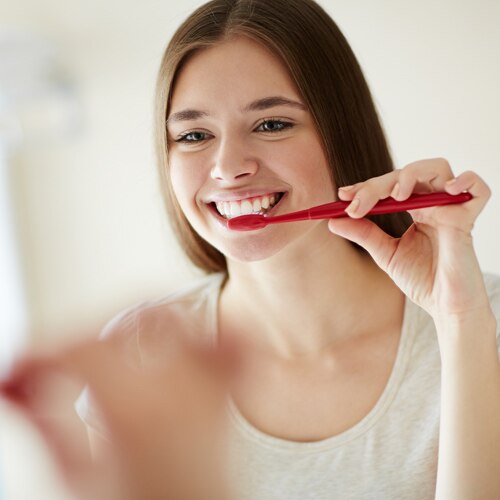Patients often ask our advice when it comes to choosing the right toothbrush. One of the most frequent questions we hear is: which is better, electric or manual? In this article, we’ll take a look at the benefits of each and discuss which toothbrush to recommend to your patients based on their individual oral health needs.
Electric toothbrushes
Much of the electric toothbrush’s movement comes from the powered brush head, so they can be easier to use (and more effective). That includes for patients with limited mobility and manual dexterity. These may include the elderly, young children and individuals with joint problems like arthritis or carpal tunnel, impaired motor skills or developmental disabilities.
Another benefit of electric toothbrushes is that they can encourage more effective brushing habits. The current recommendation is to brush twice daily for two minutes, but patients can often fall short of the mark. Many electric toothbrushes feature timers to encourage the correct brushing duration, along with 30-second “spacing” notifications to ensure equal attention to all four quadrants of the mouth. Some also feature pressure sensors, which alert the user when they’re brushing too hard. This can be especially beneficial for patients at risk of enamel or dentin loss and/or gingival abrasion.
Many electric toothbrushes can now be paired with smartphone apps to increase the effectiveness of brushing even further. The hum brush and the Colgate Smart Electronic Toothbrush E1 both connect to smartphone apps that track toothbrushing activity. As well as sending brushing reminders to the user’s phone, they feature smart sensor technology to track how much of the mouth is covered and highlight neglected areas. They also use “gamification”, turning toothbrushing into a fun game and rewarding users for positive brushing habits, and coach patients on brushing.
It can be difficult to properly clean around orthodontic brackets, wires and other fixtures, putting orthodontic patients at higher risk of developing carious lesions and gingival inflammation. An electric toothbrush can help them to achieve a more effective clean than a manual toothbrush and reduce their risk of oral health complications. As we also know, some of our younger patients can be reluctant brushers! Children often find electric toothbrushes much more fun to use, especially those that feature fun colors or favorite characters.
So does that mean you should always recommend an electric toothbrush to all of your patients? Not necessarily. Let's look now at manual toothbrushes more closely.
Manual toothbrushes
There are a number of reasons an electric toothbrush may not be suitable for a patient, for example:
They can’t afford it.
They don’t like the sensation of a powered brush.
They’re simply happy with their manual toothbrush and doing a great job!
Whatever their reason, the are many options to choose from. The American Dental Association (ADA) confirms that manual and electric toothbrushes are effective.
For general oral health, a manual toothbrush with soft bristles is recommended by the ADA. Examples include the Colgate 360 Toothbrush which has soft tapered bristles and soft rubber polishing cups. With a chunkier, ergonomically designed handle and soft grips, the Colgate 360 is easy to use and also an ideal manual recommendation for patients with limited mobility or dexterity. This brush also features a cheek and tongue cleaner and a raised cleaning tip. For patients with gingival inflammation, you might wish to recommend an ultra-soft manual toothbrush to minimize irritation. One such brush is the Colgate Gum Health Manual Toothbrush, proven to deliver 300% better gum health improvement compared to a regular flat-trimmed brush.
Patients with smaller mouths and/or crowded dentition can find it harder to clean tight spaces effectively. A manual brush like the Colgate Slim Soft can help, with a smaller head and slimmer bristles to clean harder-to-reach areas of the mouth.
Orthodontic patients can benefit from a toothbrush with a smaller head and U-shaped bristles, like the Colgate Slim Soft Ortho. This design makes it much easier to maneuver around brackets and wires for a more effective clean.
For your younger patients a specially designed manual toothbrush with a chunky, easy-grip handle, a small head, and extra-soft bristles is helpful. To encourage brushing, Colgate offers a range of fun, colorful toothbrushes featuring popular characters like Batman and Minions brushes.
Last but not least, the Colgate Magik Toothbrush is a new option for children. It is a manual brush and also connects to an augmented reality app, turning toothbrushing into a rewarding, interactive experience with games and rewards. Parents can supervise brushing habits through the app's parental dashboard.
Whichever toothbrush you recommend to your patients, the most important thing is to ensure that they’re educated on proper oral hygiene practices. Used correctly, both manual and electric toothbrushes can support positive long-term oral health, so ask your patients about their brushing habits, recommend brushes that will work for a particular patient, and make sure patients are getting the most out of their toothbrush.


Was this article helpful?
If you’d like a response, Contact Us.